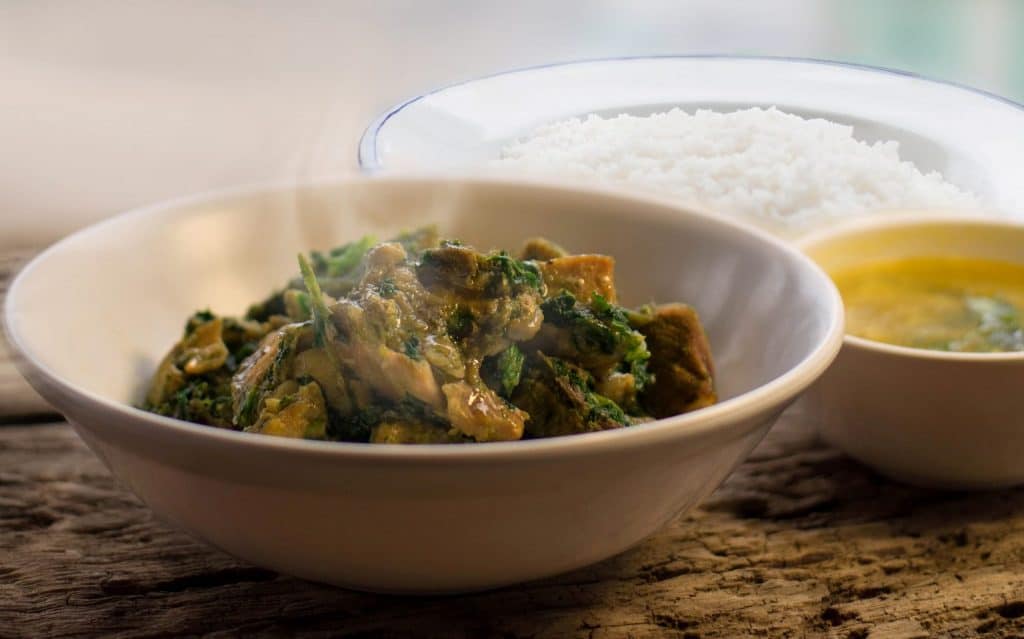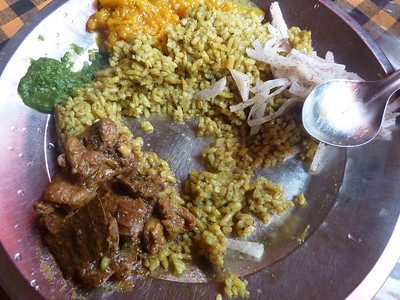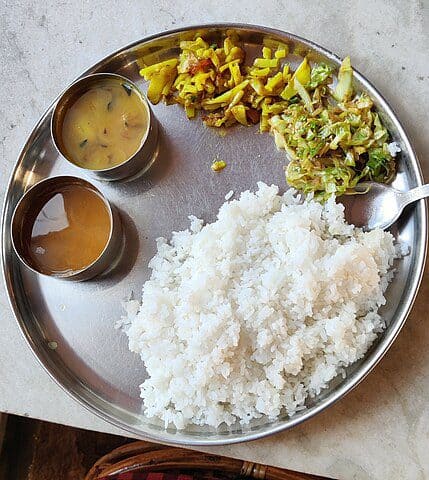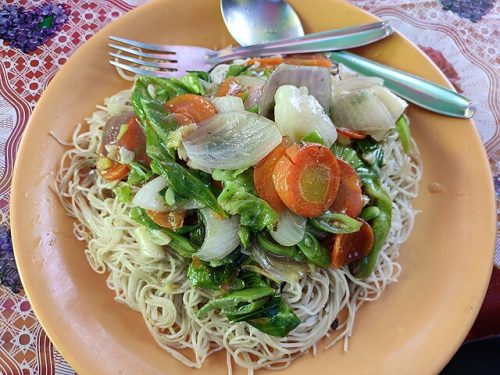When in Meghalaya, don’t count calories, count the delicious dishes that Khasi cuisine offers!

Have you wondered how to learn more about the Khasi people and their amazing food? They’re the largest tribal community in Meghalaya, and their culinary heritage is fascinating. Let us take you on a delicious journey through the vibrant and diverse cuisine of Meghalaya.
First off, the Khasi kitchen is a special place, usually run by the women in the family. It’s where age-old recipes are passed down through generations and often given a modern twist. Imagine a space where the flavours of the past meet the innovations of today, creating something truly unique.
One of the coolest things about Khasi cuisine is the stories and legends behind it. There’s this beautiful tale about two friends, one rich and one poor, who stay loyal to each other. Because of this, it’s a tradition in Khasi homes to serve kwai (betel nut) as a symbol of friendship and equality. Another interesting aspect is their use of weiñ, black clay pots, for cooking dishes like putharo and pusain, which adds a special touch to the meals. The Garos, another tribal group in Meghalaya, use these pots to ferment rice wine, making their celebrations even more special.
Khasi food is super diverse, changing from one region to another. For example, while the Khasis love their pork with fermented soya beans, the Garos use a local soda in their dishes that adds a unique flavour and tenderizes the meat. The Jaintias, on the other hand, cook pork with black sesame seeds and always have a boiled vegetable side dish. Unlike many other cuisines, the Khasis often cook without oil or spices, letting the natural flavours shine through.

You can’t talk about Khasi food without mentioning their staple ingredients: rice and pork. But there’s so much more! Bamboo shoots are a big hit, often stir-fried with mushrooms, chicken, or pork. Jadoh, a rice and pork dish, is a must-try, usually served with fish and eggs. Then there’s Dohkileh, a pork salad that can be as simple or as fancy as you like, with fresh vegetables and a tangy mix of onions, green chillies, and ginger. For something versatile and tasty, try Pumaloi, a steamed rice cake with coconut, or end your meal with Pukhlein, a sweet treat made from rice and jaggery.
Khasi cuisine isn’t just about home-cooked meals; their street food scene is vibrant too. If you find yourself in Shillong, check out the food stalls selling Jadoh, Dohneiiong (pork with bamboo shoots), and Tungrymbai (fermented soya bean chutney).
For a dining experience with a view, head to Sky Grill or Sohra House in Cherrapunji, where you can enjoy authentic Khasi dishes while taking in the breathtaking views of the Seven Sisters Waterfalls. And don’t miss the culinary magic of sisters Daphimanroi and Dakiwanri Warjri in Shillong. Through their home chef venture Symbai, they’re putting traditional Khasi food on the map with pop-up events across India.
Unique Ingredients and cooking styles in Khasi cuisine
The Khasi people from Meghalaya use unique ingredients and cooking techniques that make their cuisine stand out from other Indian culinary traditions. Let us tell you all about it!
One of the standout ingredients is Lakadong Turmeric. This turmeric is known for its high curcumin content, which gives it a vibrant colour and health benefits. It’s a prized ingredient in Khasi cooking. Another staple in Khasi food is bamboo shoots. They add a distinctive flavour and crunch to both vegetarian and non-vegetarian dishes. Black sesame seeds are also commonly used, especially in dishes like Dohneiiong, which is pork cooked in a black sesame paste. These seeds give a rich, nutty flavour to the food.
Fermented soya beans, known as Tungrymbai, add depth to many dishes, particularly pork preparations. They have a strong aroma and are a key part of the Khasi culinary tradition. Wild mushrooms foraged from local forests enhance the earthy flavours of many Khasi dishes. And then there’s Kwai (betel nut), which is more than just an ingredient; it’s a cultural practice. Chewing kwai is common among the Khasi, often served with betel leaves and lime paste as a social gesture.
When it comes to cooking techniques, Khasi cuisine tends to use minimal spices, relying on ingredients like onions, ginger, and turmeric to enhance flavours without overpowering them. Smoking meats and fermenting ingredients are traditional methods that give dishes unique flavours, especially in smoked pork salads.
Popular Khasi dishes
Now, let’s talk about some popular dishes. Jadoh is a beloved dish made with rice and pork, often cooked with aromatic vegetables and spices. It’s a perfect example of the region’s culinary simplicity. Dohkileh is a pork salad that emphasizes the natural flavours of the meat, prepared with minimal seasoning. Pumaloi is a steamed rice cake made from powdered rice, typically enjoyed at any meal.

Khasi cuisine also has some fascinating fermented foods. Tungrymbai is a fermented soybean product with a pungent flavor, often used as a condiment or in salads. Tungtap is fermented fish, usually salted and left to ferment in earthen pots, giving it a distinct umami flavour used in curries or as a side dish. Lungsiej, and fermented bamboo shoots, add a sour and tangy taste to various dishes.
The Khasi people also enjoy unique fermented beverages. Chubitchi is a traditional fermented rice drink from the Garo Hills, with a slightly alcoholic content and a unique flavour. It’s often consumed during festivals and gatherings. Another interesting drink is Khar, made from the alkaline water of the “pencil tree” (Alstonia scholaris). And, of course, there are various forms of rice beer brewed across Meghalaya, each tribe having its own method and recipe.
Traditional festivals – a perfect time to experience Khasi dishes
Khasi dishes take centre stage during several traditional festivals in Meghalaya. These festivals are a perfect time to experience the rich flavours and community spirit of Khasi culture.
One of the biggest celebrations is Shad Suk Mynsiem, the harvest festival. It’s all about giving thanks and bringing people together. Families prepare elaborate meals, featuring traditional dishes like Jadoh and Dohneiiong, and share them with friends and relatives. It’s a beautiful way to experience the community’s warmth and gratitude.
Another major festival is Ka Pomblang Nongkrem. This event is filled with rituals and, of course, lots of delicious food. You’ll find dishes like Pumaloi and tungrymbai (fermented soybean chutney) being served, showcasing the unique culinary heritage of the Khasi people.
Then there’s the Nongkrem Dance Festival, a vibrant celebration of traditional dance and music. Alongside the performances, there’s a feast of local delicacies, including Dohkileh and Pukhlein. It’s a fantastic opportunity to taste the rich and diverse flavours of Khasi food while enjoying the cultural festivities.
These festivals are not just about food; they’re about preserving Khasi culinary traditions and fostering a sense of community through shared meals and cultural practices. If you get a chance, definitely try to experience one of these festivals for a true taste of Meghalaya’s vibrant culture and cuisine!
Explore Khasi traditional food: Street Food
When you’re out and about, especially in Shillong, you can’t miss the famous street food. One must-try dish is Jadoh, a signature Khasi meal made of red rice and pork, often served with fish or chicken. It’s rich in flavour and a definite must-try.
Another popular street food is Doh-Khlieh, a minced pork salad mixed with onions and chillies. It’s both delicious and healthy, showcasing the fresh ingredients of the region. Dohneiiong features pork cooked with black sesame seeds and soy sauce, creating a rich and flavorful experience. For those who love bold flavours, Chilly Pork combines pork with spicy chilli sauce, making it a favorite among locals. You also can’t miss Momos, steamed dumplings filled with pork or chicken, served with a spicy chutney. For a sweet treat, try Pukhlein, made from fermented rice and often served as a dessert. Fried Noodles, garnished with vegetables and spices, provide a quick and delicious meal option.
If you want to experience Khasi cuisine in a more curated setting, check out the Symbai pop-ups. Run by sisters Daphimanroi and Dakiwanri Warjri, these events showcase traditional dishes like Soh Khleh and Pumaloi, introducing Khasi flavours to a wider audience.
Vegetarians, don’t worry—Shillong’s street food scene has plenty of unique options for you too. Tungrymbai is a fermented soybean dish, often enjoyed with bread or roti. Aloo Muri is a spicy potato snack made with boiled potatoes, mustard oil, and local spices. Pukhlein, the sweet fermented rice dish, is also a beloved treat among vegetarians.

You’ll also find various chaat options, like pani puri and bhel puri, which offer a mix of flavours and textures. Vegetable Chowmein, prepared with vegetables and local spices, is another popular vegetarian option. And don’t miss Phan Tungtap, a dish made with boiled red potatoes mixed with fermented dry fish and wild edible greens for a unique taste experience.
Where to find Signature Dishes from Khasi Chefs, Popups and Restaurants
Look no further if you’re curious about who’s putting Khasi cuisine on the map. For a sit-down meal with a view, head to Sky Grill in Cherrapunji. This restaurant offers breathtaking views alongside authentic Khasi dishes like Jadoh and Dohneiiong. Another great spot is Sohra House, also in Cherrapunji. They serve traditional Khasi food with a focus on local ingredients, providing a unique and memorable dining experience.
Helping to elevate Khasi food profile in the culinary world are the Symbai Sisters, Daphimanroi and Dakiwanri Warjri. Through their home chef venture, they showcase authentic Khasi dishes at pop-up events across India, using locally sourced ingredients and traditional cooking methods. Their unique twist on traditional flavours and ingredients is something you definitely don’t want to miss.
One of their standout dishes is Nei-lieh Hummus. Imagine traditional hummus but with a Khasi twist—black sesame seed paste. It’s a delightful appetizer, especially when paired with pita bread. You can often find this at the Symbai pop-ups they host.
Another must-try dish is Ja Stem. This is rice steamed with Lakadong turmeric, which is famous in Khasi food for its vibrant colour and high curcumin content. It’s usually served with Muli Khleh (radish with perilla) and Sohbaingon Dieng (tree tomato) as part of the main course. The combination is simply delicious and offers a true taste of Meghalaya.
If you’re a fan of chicken curry, you’ll love Doh Syiar Nei-iong. This dish features chicken cooked with black sesame seeds, showcasing the versatility of this ingredient in Khasi food. It’s another signature offering you’ll find at the sisters’ pop-ups.
For dessert, they’ve created something truly special: Purple Sticky Rice with Crème Anglaise and Fruit Compote. While not a traditional Khasi dessert, this dish blends traditional sticky rice with a Western-style crème anglaise and a fruit compote. It’s a perfect example of how they mix traditional elements with contemporary culinary techniques.
These signature dishes highlight how chefs like the Symbai Sisters or Warjri sisters as they are often alluded to – are elevating Khasi food by showcasing its unique flavours and ingredients while also incorporating modern culinary elements. It’s a delicious journey through the rich culinary heritage of Meghalaya with a contemporary twist. Enjoy your culinary adventure through Khasi cuisine!
Read More: Latest



